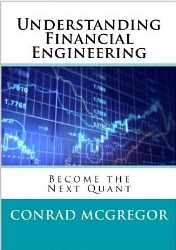The market can often seem like it has a case of Memento. One day we are trading euphorically upward (like today) and the next we see a panic stricken sell off. I have made a point in the past that I believe the positive (or negative) feedback loops are stronger in modern markets, that high frequency trading does not replace human market makers, and that the removal of the uptick rule might be the dumbest thing the SEC has ever done (that’s saying quite a bit). Instead of spouting off opinion, it might be worth a little bit of analysis.
If we look at 20-day or 1 month realized volatility of the S&P 500 it is easy to dig into the extremes. In the chart below it is simple to identify A) the great depression, B) the 1987 crash and C) the global financial crisis of 2008/2009:
Aside from the obvious spikes, you could also make the case that since the late 1990’s we have experienced higher volatility levels that are higher than any aside from the great depression. One thought strikes me as particularly interesting: would you not think that there is more liquidity in today’s electronic and global markets than during the great depression? Would this not imply that less liquidity in the 20’s and 30’s could have exacerbated the volatility in the markets as there were fewer buyers and sellers to jump in front of moving freight trains?
Let us take a different approach and think about volatility in a slightly spread oriented way. The first sentence of this post struck at the bipolar nature of today’s modern market. In times of calm, the market seems too calm. In times of stress, the market seems too stressed. If we look at this same data and take the difference between the 75th percentile of 20-day volatility observations and the 25th percentile of volatility observations we get a slightly different picture:
The data shows that the middle band of volatility outcomes has become extremely bipolar with 2008 leading the pack.
Let us write down a list of the possible reasons in no particular order:
- Lack of human market makers
- Abundance of computerized programs looking for mean reversion in calm markets and momentum in moving markets
- Abundance of hedging from Insurance companies, Banks, Pension funds etc.
- Removal of an uptick rule
- Federal reserve zero interest rate policy
- Leverage
I do not have the answer, but it is probably a combination of all of the above
A Demon of Our Own Design: Markets, Hedge Funds, and the Perils of Financial Innovation
Inside markets, innovation, and risk
Why do markets keep crashing and why are financial crises greater than ever before? As the risk manager to some of the leading firms on Wall Street–from Morgan Stanley to Salomon and Citigroup–and a member of some of the world’s largest hedge funds, from Moore Capital to Ziff Brothers and FrontPoint Partners, Rick Bookstaber has seen the ghost inside the machine and vividly shows us a world that is even riskier than we think. The very things done to make markets safer, have, in fact, created a world that is far more dangerous. From the 1987 crash to Citigroup closing the Salomon Arb unit, from staggering losses at UBS to the demise of Long-Term Capital Management, Bookstaber gives readers a front row seat to the management decisions made by some of the most powerful financial figures in the world that led to catastrophe, and describes the impact of his own activities on markets and market crashes. Much of the innovation of the last 30 years has wreaked havoc on the markets and cost trillions of dollars. A Demon of Our Own Design tells the story of man’s attempt to manage market risk and what it has wrought. In the process of showing what we have done, Bookstaber shines a light on what the future holds for a world where capital and power have moved from Wall Street institutions to elite and highly leveraged hedge funds.Inside markets, innovation, and risk
Why do markets keep crashing and why are financial crises greater than ever before? As the risk manager to some of the leading firms on Wall Street–from Morgan Stanley to Salomon and Citigroup–and a member of some of the world’s largest hedge funds, from Moore Capital to Ziff Brothers and FrontPoint Partners, Rick Bookstaber has seen the ghost inside the machine and vividly shows us a world that is even riskier than we think. The very things done to make markets safer, have, in fact, created a world that is far more dangerous. From the 1987 crash to Citigroup closing the Salomon Arb unit, from staggering losses at UBS to the demise of Long-Term Capital Management, Bookstaber gives readers a front row seat to the management decisions made by some of the most powerful financial figures in the world that led to catastrophe, and describes the impact of his own activities on markets and market crashes. Much of the innovation of the last 30 years has wreaked havoc on the markets and cost trillions of dollars. A Demon of Our Own Design tells the story of man’s attempt to manage market risk and what it has wrought. In the process of showing what we have done, Bookstaber shines a light on what the future holds for a world where capital and power have moved from Wall Street institutions to elite and highly leveraged hedge funds.






